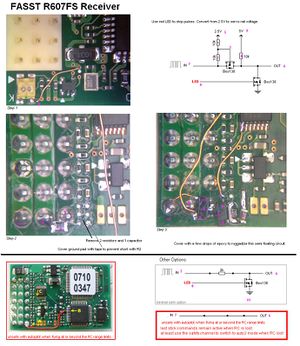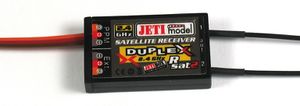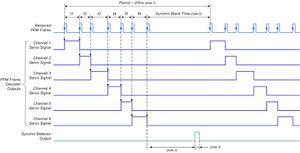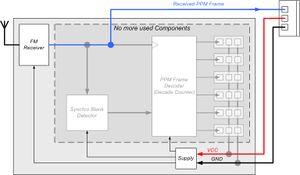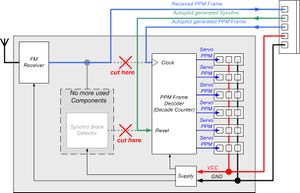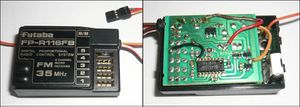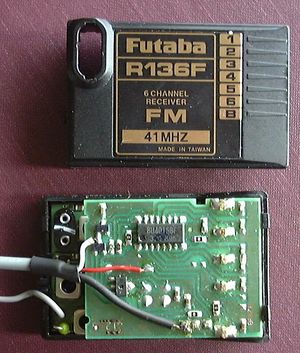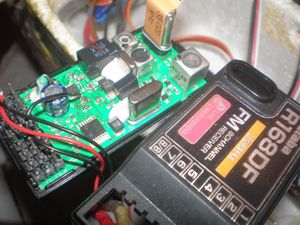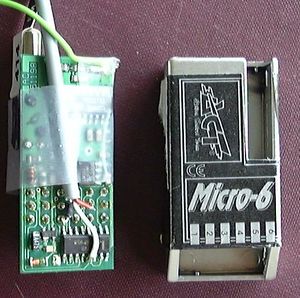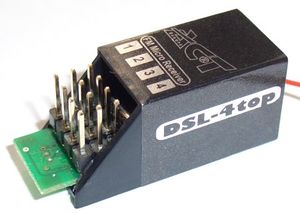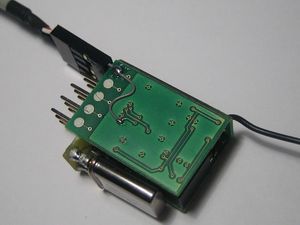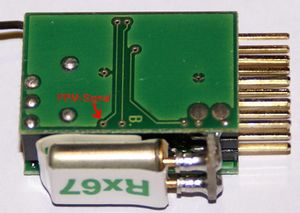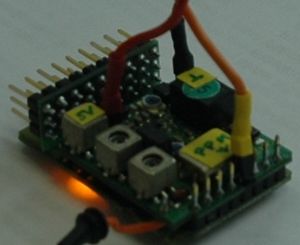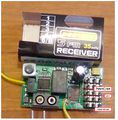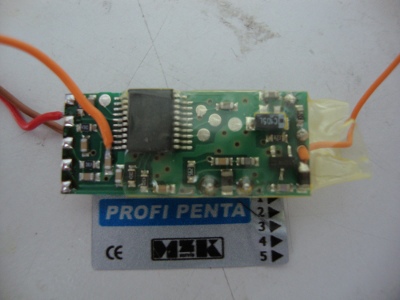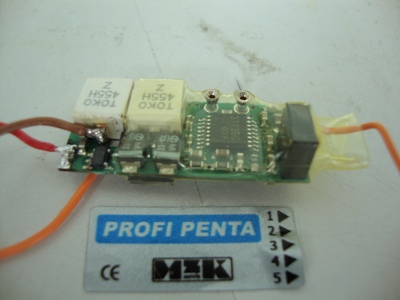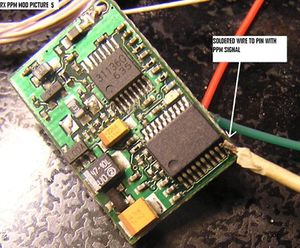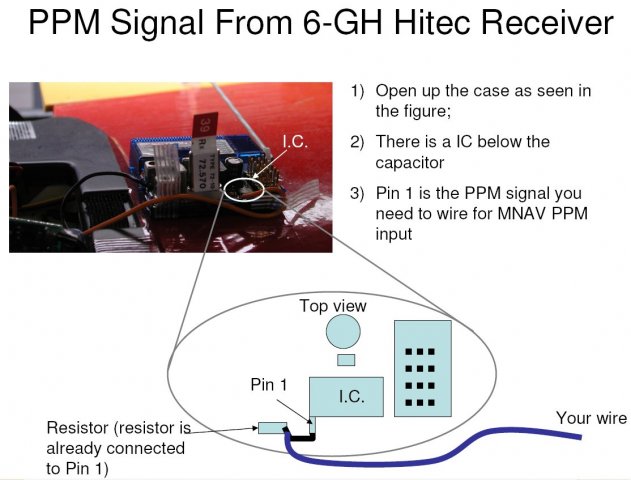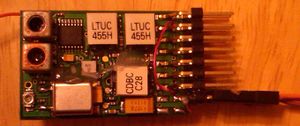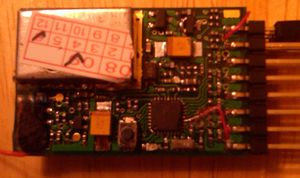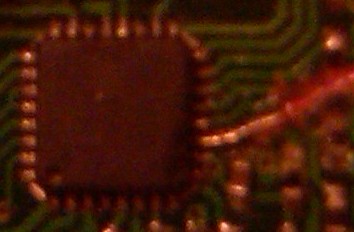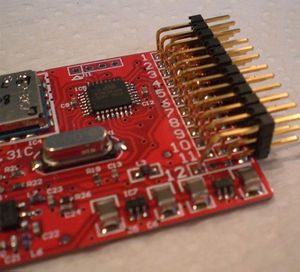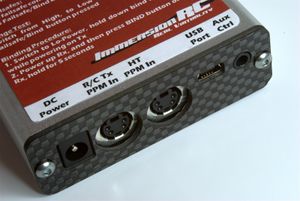Difference between revisions of "RC Receivers and Radios"
m |
m |
||
| Line 2: | Line 2: | ||
To be able to test your airframe before it flies fully autonomous a regular RC transmitter in combination with a receiver can be used. This makes testing and tuning your airframe so much easier. For this to work the received steering commands have to leave the receiver. Only then with this data the autopilot when vlown in manual mode can do something you tell it to. This page is to give you information of how to connect various receivers. Also how to modify receiver so they can talk to the autopilot. | To be able to test your airframe before it flies fully autonomous a regular RC transmitter in combination with a receiver can be used. This makes testing and tuning your airframe so much easier. For this to work the received steering commands have to leave the receiver. Only then with this data the autopilot when vlown in manual mode can do something you tell it to. This page is to give you information of how to connect various receivers. Also how to modify receiver so they can talk to the autopilot. | ||
=Setup= | |||
Once you have physically connected your receiver we need to setup the transmitter and receiver combination correctly. This can be an complex task due to the overwhelming amount of options. [rc_transmitter_and_receiver_setup To assist you in this setup quest a specific wiki page is created]. | |||
=2.4GHz Receivers= | =2.4GHz Receivers= | ||
| Line 26: | Line 30: | ||
* Do not forget to use channel 3 (only failsafe channel) as mode switch with fail safe "throttle off" as mode 2. | * Do not forget to use channel 3 (only failsafe channel) as mode switch with fail safe "throttle off" as mode 2. | ||
==Robbe RASST 7 & 8 channel receivers == | ==Robbe RASST 7 & 8 channel receivers== | ||
Robbe has produced line of Futaba FASST compatible receivers that can output only PPM which results ablility to plug into autopilot without encoder. | Robbe has produced line of Futaba FASST compatible receivers that can output only PPM which results ablility to plug into autopilot without encoder. | ||
| Line 32: | Line 36: | ||
* [http://www.robbe.de/empf-r6107sp-2-4-ghz-rasst.html R6107SP 2,4 GHz RASST] - 7 channel, >1000m range | * [http://www.robbe.de/empf-r6107sp-2-4-ghz-rasst.html R6107SP 2,4 GHz RASST] - 7 channel, >1000m range | ||
* [http://www.robbe.de/empf-r6008sp-2-4-ghz-rasst.html R6008SP 2,4 GHz RASST] - 8 channel, upto 3000m range | * [http://www.robbe.de/empf-r6008sp-2-4-ghz-rasst.html R6008SP 2,4 GHz RASST] - 8 channel, upto 3000m range | ||
===Switch Assignment=== | ===Switch Assignment=== | ||
| Line 65: | Line 68: | ||
More information can be found a the [http://www.jetimodel.cz/index.php?page=product&id=165 Homepage of Jeti] and the [http://www.mikrokopter.de/ucwiki/JetiDuplex MikroKopter Wiki]. | More information can be found a the [http://www.jetimodel.cz/index.php?page=product&id=165 Homepage of Jeti] and the [http://www.mikrokopter.de/ucwiki/JetiDuplex MikroKopter Wiki]. | ||
=PCM Receivers= | |||
Most of the known PCM transmitter also can be set to PPM mode. If this is set, then the regular description for PPM applies since the PCM receiver like a JR/Gaupner SMC16 Scan can output PPM perfectly. | Most of the known PCM transmitter also can be set to PPM mode. If this is set, then the regular description for PPM applies since the PCM receiver like a JR/Gaupner SMC16 Scan can output PPM perfectly. | ||
| Line 130: | Line 77: | ||
# At least one extra channel beyond those needed to control the servos and motor. | # At least one extra channel beyond those needed to control the servos and motor. | ||
= PPM Receivers = | |||
== | == Requirements == | ||
To use a 26/27/35/40/41/72/ MHz receiver a few requirements are necessary | |||
# At least one extra channel beyond those needed to control the servos and motor. | # At least one extra channel beyond those needed to control the servos and motor. | ||
# A modified receiver which outputs a full ppm signal. | # A receiver or modified receiver which outputs a full ppm signal. | ||
== | == R/C Receiver Interface== | ||
All versions of the Paparazzi autopilot include a connector to interface with a standard R/C receiver for manual or semi-autonomous control during the testing and tuning phases. Two interface options exist: | All versions of the Paparazzi autopilot include a connector to interface with a standard R/C receiver for manual or semi-autonomous control during the testing and tuning phases. Two interface options exist: | ||
# Tap into the PPM signal running between the RF section and the servo driver of your receiver and route it to the Paparazzi. Let the Paparazzi generate individual servo signals and connect all servos directly to the autopilot. This method requires only 3 wires to the receiver (power and PPM), is compatible with all Paparazzi autopilots, and provides 8 manual R/C channels and the potential for more autonomous channels regardless of the capability of the R/C receiver. | # Tap into the PPM signal running between the RF section and the servo driver of your receiver and route it to the Paparazzi. Let the Paparazzi generate individual servo signals and connect all servos directly to the autopilot. This method requires only 3 wires to the receiver (power and PPM), is compatible with all Paparazzi autopilots, and provides 8 manual R/C channels and the potential for more autonomous channels regardless of the capability of the R/C receiver. | ||
| Line 163: | Line 95: | ||
[[Image:RC_Receiver_Tiny.jpg|thumb|left|3-Wire setup, driving servos from the autopilot]] | [[Image:RC_Receiver_Tiny.jpg|thumb|left|3-Wire setup, driving servos from the autopilot]] | ||
[[Image:RC_Receiver_classix.jpg|thumb|left|4-Wire setup, driving servos from the R/C receiver]] | [[Image:RC_Receiver_classix.jpg|thumb|left|4-Wire setup, driving servos from the R/C receiver]] | ||
=== Common demux chips === | === Common demux chips === | ||
| Line 173: | Line 104: | ||
In most receivers you are after the clock; though some may be pulsed; in which case you need the enable. Note that the 4017 enable has inverted logic (low to be enabled) whereas the input on the 4015 can be either (typically high). If the enable pin is held low (4017) or if the input pin (4015) is held high always;e.g. connected to the ground or the Vcc - then it is fair to assume that the PPM signal is most propably on the clock input. | In most receivers you are after the clock; though some may be pulsed; in which case you need the enable. Note that the 4017 enable has inverted logic (low to be enabled) whereas the input on the 4015 can be either (typically high). If the enable pin is held low (4017) or if the input pin (4015) is held high always;e.g. connected to the ground or the Vcc - then it is fair to assume that the PPM signal is most propably on the clock input. | ||
== Recommended 35/40Mhz RC Receivers == | |||
Note that there is information on modifying other receiver models at [http://mikrokopter.de/ucwiki/RC-Empf%C3%A4nger mikrokopter.de]. It's in German however the pictures contain most of the information or use google translate. | Note that there is information on modifying other receiver models at [http://mikrokopter.de/ucwiki/RC-Empf%C3%A4nger mikrokopter.de]. It's in German however the pictures contain most of the information or use google translate. | ||
Shielded wire is recommended for receiver and autopilot connection, as unshielded one may cause noise in receiver. | Shielded wire is recommended for receiver and autopilot connection, as unshielded one may cause noise in receiver. | ||
=== Futaba FP-R116FB 6 Channel FM 35MHz receiver === | |||
[[Image:Rc_fut_web.jpg|thumb|left|Wiring of a Futaba R136]] | [[Image:Rc_fut_web.jpg|thumb|left|Wiring of a Futaba R136]] | ||
| Line 186: | Line 117: | ||
<br style="clear:both"> | <br style="clear:both"> | ||
=== Futaba R136F 6 Channel FM receiver === | |||
[[Image:rx_futaba136.jpg|thumb|left|Wiring of a Futaba R136]] | [[Image:rx_futaba136.jpg|thumb|left|Wiring of a Futaba R136]] | ||
*41 MHz | *41 MHz | ||
*White wire is connected to PPM signal | *White wire is connected to PPM signal | ||
=== Futaba R168DF 8 Channel dual FM receiver === | |||
[[Image:rx_futaba168df.jpg|thumb|left|Wiring of a Futaba R168DF]] | [[Image:rx_futaba168df.jpg|thumb|left|Wiring of a Futaba R168DF]] | ||
*35 MHz | *35 MHz | ||
*PPM wire is connected to 862 receiver pin on the board. VCC and GND is on the 8/B original position. | *PPM wire is connected to 862 receiver pin on the board. VCC and GND is on the 8/B original position. | ||
=== ACT Micro-6 FM receiver === | |||
[[Image:rx_act_micro-6.jpg|thumb|left|Wiring of a ACT Micro-6]] | [[Image:rx_act_micro-6.jpg|thumb|left|Wiring of a ACT Micro-6]] | ||
| Line 207: | Line 137: | ||
<br style="clear:both"> | <br style="clear:both"> | ||
=== ACT DSL-4top [http://www.mikrokopter.de/ucwiki/DSL4top mikrokopter.de] version === | |||
[[Image:DSL4top.jpg|thumb|left|DSL-4top mikrokopter.de version]] | [[Image:DSL4top.jpg|thumb|left|DSL-4top mikrokopter.de version]] | ||
* Special version for mikrokopter.de - Only available in their [https://www.mikrocontroller.com/index.php?main_page=product_info&products_id=215&zenid=8ce8bab70f3e9d684e01f724316d9690 shop]! | * Special version for mikrokopter.de - Only available in their [https://www.mikrocontroller.com/index.php?main_page=product_info&products_id=215&zenid=8ce8bab70f3e9d684e01f724316d9690 shop]! | ||
| Line 214: | Line 144: | ||
* ACT Lifetime warranty | * ACT Lifetime warranty | ||
* Sells for ~45 euro | * Sells for ~45 euro | ||
===Futaba R115F 5 Channel FM receiver=== | |||
[[Image:pprz_rx115.jpg|thumb|left|Wiring of a Futaba R115]] | [[Image:pprz_rx115.jpg|thumb|left|Wiring of a Futaba R115]] | ||
*Available in 35 and 40 MHz versions | *Available in 35 and 40 MHz versions | ||
*White wire is connected to PPM signal | *White wire is connected to PPM signal | ||
===JETI REX 5 plus (no MPD) receiver=== | |||
[[Image:520_Jeti_5_plus.jpg|thumb|left|Wiring of a REX 5]] | [[Image:520_Jeti_5_plus.jpg|thumb|left|Wiring of a REX 5]] | ||
| Line 232: | Line 161: | ||
<br style="clear:both"> | <br style="clear:both"> | ||
[[Image:DSC02414.JPG|thumb|left|other Layout of REX 5]] | [[Image:DSC02414.JPG|thumb|left|other Layout of REX 5]] | ||
=== Receiver RX-7-SYNTH IPD receiver [http://www.multiplex-rc.de/hp/produkte/artikel_detail.jsp?lfdnr=55880&action=add2notice&qty=1&cachenepper=1227896925116 Multiplex-rc.de] === | |||
[[Image:RX-7-SYNTH_IPD.jpg|thumb|left|Wiring of RX-7-SYNTH IPD]] | [[Image:RX-7-SYNTH_IPD.jpg|thumb|left|Wiring of RX-7-SYNTH IPD]] | ||
| Line 240: | Line 168: | ||
*A compact, high-quality 7-channel single-conversion FM / PPM IPD receiver | *A compact, high-quality 7-channel single-conversion FM / PPM IPD receiver | ||
*Easy modification through connectors, see pictures | *Easy modification through connectors, see pictures | ||
=== Protech 5FM 35 mHz Receiver ==== | |||
The low cost Protech '5FM' receiver makes use of an SMD version of the standard 74AHC164[http://www.ic-on-line.cn/IOL/datasheet/74ahct164_18057.pdf] 8 bit shift register; you are after PIN 1 of this chip. The circuit board has a testpad for just this pin at the top side of the circuit board. | The low cost Protech '5FM' receiver makes use of an SMD version of the standard 74AHC164[http://www.ic-on-line.cn/IOL/datasheet/74ahct164_18057.pdf] 8 bit shift register; you are after PIN 1 of this chip. The circuit board has a testpad for just this pin at the top side of the circuit board. | ||
| Line 258: | Line 185: | ||
This is further compunded by the relatively noisy electrical engines; which are not brushless. A ferrite coil does not seem to help enough - Papparazi and GPS loose sync often through Xbee. Replacing the engine by a brushless outrunnen resolve the issue completely. | This is further compunded by the relatively noisy electrical engines; which are not brushless. A ferrite coil does not seem to help enough - Papparazi and GPS loose sync often through Xbee. Replacing the engine by a brushless outrunnen resolve the issue completely. | ||
===Profi Penta 35 MHz=== | |||
[[Image:DSC00547.JPG]] | [[Image:DSC00547.JPG]] | ||
[[Image:DSC00545.JPG]] | [[Image:DSC00545.JPG]] | ||
=== | ==72Mhz Receivers == | ||
===Castle Creations [http://www.castlecreations.com/products/berg_ms4l.html Berg 4L]=== | |||
[[Image:berg4L.jpg|thumb|Wiring of a Berg 4L]] | [[Image:berg4L.jpg|thumb|Wiring of a Berg 4L]] | ||
* Expect fantastic performance from these $40 USD parts but be warned that they are known to have unreliable crystal sockets and brittle antenna wire. The ''Berg 7'' channel receiver should work equally well and is known to have a better crystal socket - note that either receiver will provide '''8 channels''' in manual R/C mode when used with Paparazzi. Note: the rugged ''Berg 4'' cannot be modified, only the ''Berg 4L'' and ''Berg 7''. | * Expect fantastic performance from these $40 USD parts but be warned that they are known to have unreliable crystal sockets and brittle antenna wire. The ''Berg 7'' channel receiver should work equally well and is known to have a better crystal socket - note that either receiver will provide '''8 channels''' in manual R/C mode when used with Paparazzi. Note: the rugged ''Berg 4'' cannot be modified, only the ''Berg 4L'' and ''Berg 7''. | ||
| Line 276: | Line 204: | ||
# Use some large shrink wrap to cover the entire receiver again | # Use some large shrink wrap to cover the entire receiver again | ||
===Hitec Electron 6 72MHz Reciever=== | |||
This was written for MNAV from crossbow but is still usable with PPRZ. | This was written for MNAV from crossbow but is still usable with PPRZ. | ||
[[Image:Electron6mod.jpg]] | [[Image:Electron6mod.jpg]] | ||
===Corona Synthesized Dual-Conv Receiver 8Ch=== | |||
[http://www.corona-rc.com/coproductshowE.asp?ArticleID=63 manual] | [http://www.corona-rc.com/coproductshowE.asp?ArticleID=63 manual] | ||
This receiver is available in 27,35,36,40,72 mhz and a Synthesized receiver, meaning you do not need to change frequency crystals. | This receiver is available in 27,35,36,40,72 mhz and a Synthesized receiver, meaning you do not need to change frequency crystals. | ||
| Line 302: | Line 231: | ||
<br style="clear:both"> | <br style="clear:both"> | ||
=UHF Receivers= | |||
Note that in most countries an amateur radio license is required to use 433MHz UHF. | Note that in most countries an amateur radio license is required to use 433MHz UHF. | ||
==Scherrer UHF== | |||
[[Image:ScherrerUHF.jpg|thumb|left|Scherrer UHF Rx]] | [[Image:ScherrerUHF.jpg|thumb|left|Scherrer UHF Rx]] | ||
| Line 314: | Line 243: | ||
<br style="clear:both"> | <br style="clear:both"> | ||
==ImmersionRC EzUHF== | |||
[[Image:EzUHFTx.jpg|thumb|left|ImmersionRC Tx]] | [[Image:EzUHFTx.jpg|thumb|left|ImmersionRC Tx]] | ||
| Line 325: | Line 254: | ||
See [http://www.immersionrc.com/EzUHF.htm EzUHF manual+firmware] for more information. | See [http://www.immersionrc.com/EzUHF.htm EzUHF manual+firmware] for more information. | ||
[[Category:Hardware]] [[Category:User_Documentation]] | [[Category:Hardware]] [[Category:User_Documentation]] | ||
Revision as of 06:37, 12 April 2013
Introduction
To be able to test your airframe before it flies fully autonomous a regular RC transmitter in combination with a receiver can be used. This makes testing and tuning your airframe so much easier. For this to work the received steering commands have to leave the receiver. Only then with this data the autopilot when vlown in manual mode can do something you tell it to. This page is to give you information of how to connect various receivers. Also how to modify receiver so they can talk to the autopilot.
Setup
Once you have physically connected your receiver we need to setup the transmitter and receiver combination correctly. This can be an complex task due to the overwhelming amount of options. [rc_transmitter_and_receiver_setup To assist you in this setup quest a specific wiki page is created].
2.4GHz Receivers
If using a Lisa/M or Lisa/L autopilot board the whole range of Spektrum/JR/Hobbyking satellite receivers can be used directly connected to the AP board. If you come acroos the term "Satellite Receiver", it has notting to do with Satellites in earth orbit. It is just a term to describe an additional receiver.
For other autopilot boards to use a 2.4 GHz system a few requirements are necessary
- Must have combined PPM pulsetrain out or use PPM Encoder board. See the Get Hardware page for links to suppliers)
- At least one extra channel beyond those needed to control the servos and motor. (throttle-roll-pitch-mode)
Hobbyking orange
OrangeRx R100 Satellite Receiver ttp://www.hobbyking.com/hobbyking/store/__13418__OrangeRx_R100_Satellite_Receiver.html R100SAT
Spektrum 9645
Futaba FASST 7-channel receiver
- Pin 8 (upper right corner in picture) of the small IC on the right contains 5 PPM pulses and can go directly to paparazzi. Pulse 6 and 7 go directly to the servos.
- Best is to remove the resistors of one of the channels and connect a small wire to pin 8 to get the combined 5 pulses on the robust 1/10th inch header.
- Do not forget to use channel 3 (only failsafe channel) as mode switch with fail safe "throttle off" as mode 2.
Robbe RASST 7 & 8 channel receivers
Robbe has produced line of Futaba FASST compatible receivers that can output only PPM which results ablility to plug into autopilot without encoder.
- R6007SP 2,4 GHz RASST - 7 channel, for small aircraft
- R6107SP 2,4 GHz RASST - 7 channel, >1000m range
- R6008SP 2,4 GHz RASST - 8 channel, upto 3000m range
Switch Assignment
To assign the three position switch to any other channel but channel 7 follow these steps:
- Set up aux2(refers to aux2 on rx not the switch on the tx. aka ch7) with its input selected as 3 pos switch.
- Set up this mix - Gear to Gear (Up=-100, Down=-100, Offset =0). This inhibits the gear switch.
- Set up another mix - Aux2 to Gear (Up=100, Down=100, Offset = 0).
Notes:
- Gear on a DX-7 Air is Channel 5 and AUX2 is CH7. Once again i am referring to the inputs which are labeled on the RX not what the switches are named on the TX. If your using a DX-7 heli please substitute the names for what the rx channels are named into this guide
- DX7 Heli the 3-pos switch is named "flight mode"
- DX7 Air the 3-pos switch is named "flaps"
Failsafe Setup
To set up the mode channel (3 pos switch) to default to auto2 if connection is lost between rx and tx follow these steps:
- Put 3 position Switch into AUTO2 Position
- Put in bind plug
- Power up
- REMOVE the bind plug
- Power up Tx while pushing bind button
- Wait until light becomes steady and not blinking (it may become steady right off but will then start blinking again so let it go at least 5 seconds)
Jeti Duplex 2.4 GHz Receiver Rsat 2
- Outputs PPM, no soldering or PPM board required
- Only 12 gramms
- Full duplex technology provides safe radio link and redundant telemetry to standard paparazzi telemetry.
- Transmitter module can be installed in any receiver.
More information can be found a the Homepage of Jeti and the MikroKopter Wiki.
PCM Receivers
Most of the known PCM transmitter also can be set to PPM mode. If this is set, then the regular description for PPM applies since the PCM receiver like a JR/Gaupner SMC16 Scan can output PPM perfectly.
However if setting up you transmitter to PPM out then the following applies:
- Must use ppm encoder board. (See Get Hardware page for suppliers)
- At least one extra channel beyond those needed to control the servos and motor.
PPM Receivers
Requirements
To use a 26/27/35/40/41/72/ MHz receiver a few requirements are necessary
- At least one extra channel beyond those needed to control the servos and motor.
- A receiver or modified receiver which outputs a full ppm signal.
R/C Receiver Interface
All versions of the Paparazzi autopilot include a connector to interface with a standard R/C receiver for manual or semi-autonomous control during the testing and tuning phases. Two interface options exist:
- Tap into the PPM signal running between the RF section and the servo driver of your receiver and route it to the Paparazzi. Let the Paparazzi generate individual servo signals and connect all servos directly to the autopilot. This method requires only 3 wires to the receiver (power and PPM), is compatible with all Paparazzi autopilots, and provides 8 manual R/C channels and the potential for more autonomous channels regardless of the capability of the R/C receiver.
- Cut the PPM trace and route it thru the autopilot and back to the receiver, using the servo driver IC on your R/C receiver to drive the servos. This option requires 4 wires (Ground, PPM-in, PPM-out, Reset) and your receiver must have a supported servo driver IC. This allows you to use the large servo connectors on your R/C receiver and does not require any modification to your servos or ESC but does require you to cut a trace on your R/C receiver and limits the number of servos to the capacity of your receiver. Compatible with Classix and Tiny 1.1.
- Note that on the Classix the PPM_in pin is FOO2...
Common demux chips
Typical used chips are the cmos 4015 and 4017.
The 4015 uses either pin 1 or pin 9 for the clock and the input is on 7 and 15. The 4017 has just one shift register and has its clock input on pin 14 and the enable on pint 13.
In most receivers you are after the clock; though some may be pulsed; in which case you need the enable. Note that the 4017 enable has inverted logic (low to be enabled) whereas the input on the 4015 can be either (typically high). If the enable pin is held low (4017) or if the input pin (4015) is held high always;e.g. connected to the ground or the Vcc - then it is fair to assume that the PPM signal is most propably on the clock input.
Recommended 35/40Mhz RC Receivers
Note that there is information on modifying other receiver models at mikrokopter.de. It's in German however the pictures contain most of the information or use google translate. Shielded wire is recommended for receiver and autopilot connection, as unshielded one may cause noise in receiver.
Futaba FP-R116FB 6 Channel FM 35MHz receiver
- Orange wire is connected to PPM signal
- Red wire is connected to VCC
- Brown wire is connected to GND
Futaba R136F 6 Channel FM receiver
- 41 MHz
- White wire is connected to PPM signal
Futaba R168DF 8 Channel dual FM receiver
- 35 MHz
- PPM wire is connected to 862 receiver pin on the board. VCC and GND is on the 8/B original position.
ACT Micro-6 FM receiver
- Available in 35 or 40 MHz versions
- White wire is connected to PPM signal
- Datasheet (German)
ACT DSL-4top mikrokopter.de version
- Special version for mikrokopter.de - Only available in their shop!
- Outputs PPM directly on the channel 1 connector!
- No soldering necessary
- ACT Lifetime warranty
- Sells for ~45 euro
Futaba R115F 5 Channel FM receiver
- Available in 35 and 40 MHz versions
- White wire is connected to PPM signal
JETI REX 5 plus (no MPD) receiver
- Popular Czech made micro r/c receiver, available in 35 or 40 MHz versions
- ´folded´ PCB design with parts inside, mostly inaccessable
- Small grey wire is connected to via with PPM signal
- Unusual connector used for testing, soldering recommended
- shielded wire recommended, this one taken from PC parts recycling (former soundcard to m/b connector cable)
- Datasheet (English)
Receiver RX-7-SYNTH IPD receiver Multiplex-rc.de
- Available in 35, 36 and 40 MHz versions
- A compact, high-quality 7-channel single-conversion FM / PPM IPD receiver
- Easy modification through connectors, see pictures
Protech 5FM 35 mHz Receiver =
The low cost Protech '5FM' receiver makes use of an SMD version of the standard 74AHC164[1] 8 bit shift register; you are after PIN 1 of this chip. The circuit board has a testpad for just this pin at the top side of the circuit board.
Two physical versions exist; the older one [2] and a newer one pictured (fig 1). It has been distributed by protech with various ready-to-fly planes; such as the Skyraider[3].
The solder/testpad you are after the one right next the 74x164 chip its pin 1. In this image it has a jellow wire soldered to it (the yellow wire at the top left is the normal antenna connector (fig 2). Note however that the signal is not very clean (1v/div) - which may cause issues - as shown in the above image (fig 3).
This is further compunded by the relatively noisy electrical engines; which are not brushless. A ferrite coil does not seem to help enough - Papparazi and GPS loose sync often through Xbee. Replacing the engine by a brushless outrunnen resolve the issue completely.
Profi Penta 35 MHz
72Mhz Receivers
Castle Creations Berg 4L
- Expect fantastic performance from these $40 USD parts but be warned that they are known to have unreliable crystal sockets and brittle antenna wire. The Berg 7 channel receiver should work equally well and is known to have a better crystal socket - note that either receiver will provide 8 channels in manual R/C mode when used with Paparazzi. Note: the rugged Berg 4 cannot be modified, only the Berg 4L and Berg 7.
To Modify a Berg4L, follow these instructions:
- Remove the shrink wrap. Use a good knife and be careful to not damage any of the components on the receiver. I would recommend that you cut on the sides (edge of the PCB) to be sure to avoid damaging the shielding
- Desolder the headers. We will not use them with tiny AP as the servos are connected directly to the AP. This is pretty easy to do when you have a hot air rework station. If you don't have one, your best bet is to cut the header off and remove the left over pins one by one with a regular iron. There is a piece of shielding material that is connected to one of the ground pins of the header. You need to remove it carefully from the header without damaging it and re-solder it to the gnd pad.
- You need to solder 3 wires to the receiver. Gnd, +5V and PPM. To locate the PPM signal, first locate the PIC micro controller close to the location of the headers. The PPM signal is on the corner pin closest to the corner of the receiver. Soldering a 28guage wire directly to the PIN isn't very difficult. For the power connection, use the pads that were used for the header. The outside pin is Gnd, the second pin is +5V. What I did is solder the wires on the pad going straight down, then I looped the 3 wires 360 degrees and glued them to the PCB with hot glue. This provides good strain relief.
- While you have the PCB in your hands, take the opportunity to remove the crystal connector and solder your crystal directly to the PCB for added reliability.
- I also used some hot glue to add more strain relief to the antenna
- Use some large shrink wrap to cover the entire receiver again
Hitec Electron 6 72MHz Reciever
This was written for MNAV from crossbow but is still usable with PPRZ.
Corona Synthesized Dual-Conv Receiver 8Ch
This receiver is available in 27,35,36,40,72 mhz and a Synthesized receiver, meaning you do not need to change frequency crystals.
How to modify for combined signal
- Cut the 8th channel PWM output pin near the PCB.
- Connected a pin from the Atmel (see picture) to the 8th channel PWM signal. (optionally, weaving the wire through some holes on the board.) Make sure you have a fine tip on your soldering iron and a magnifying glass strapped to your head!
- Glue the wire down (CA works)
- Be sure to glue the pin that you cut in place (previously, being soldered to the board was holding the pin in place)
It is maybe possible to reprogram the atmel with your own firmware. If you succeed in this plz add relevant info here.
That pin provides a 1V to 2V signal, it works with the PPRZ, although its a bit gittery (the slew rate is not real good).
UHF Receivers
Note that in most countries an amateur radio license is required to use 433MHz UHF.
Scherrer UHF
The Scherrer UHF is a high quality diversity radio control system. It has a PPM output and can be connected directely to Paparazzi. A ppm encoder board is not required. It has an RSSI output.
ImmersionRC EzUHF
The ImmersionRC EzUHF is a high quality diversity radio control system. The recent firmwares have a PPM output on Ch. 1, but this needs to be activated through the PC configuration software with the proper firmware loaded. It connects directly to EzOSD and the TrackR2 which enables RSSI monitoring and head tracking for FPV.
Some people had issues with the exact timing, where the ROLL channel disappeared. If the radio has more than 6 channels, there may be methods to slave another channel to the roll channel (usually for the operation of dual ailerons). The ezuhf configuration file is using this method, where channel 1 is copied to channel 6. The EzUHF modules receive the PPM output stream from the radio and need to interpret it. For this reason, the ezuhf configuration file should be verified for proper functioning and you may find that channels are remapped to others with different purposes.
Search "sander style" antennas for a way to build your own cheap, high-quality antennas for these rx modules and which provide a range well beyond the horizon.
See EzUHF manual+firmware for more information.
